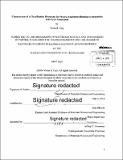Construction of a classification hierarchy for process underspecification to streamline life-cycle assessment
Author(s)
Cary, Victor E
DownloadFull printable version (3.909Mb)
Other Contributors
Massachusetts Institute of Technology. Department of Materials Science and Engineering.
Advisor
Elsa Olivetti.
Terms of use
Metadata
Show full item recordAbstract
Concerns over global warming potential and environmental degradation have created a demand for accurate assessment of the impact of various products and processes. Life cycle assessment (LCA), a quantitative assessment method, has been employed primarily to products, analyzing the energy inputs and environmental consequences for the manufacture and use of specific goods. While it has not seen widespread use in assessment of industrial processes, its methodology can be adapted for such purposes; indeed, LCA may be a powerful tool for analyzing processes. This thesis aims to explore the viability of LCA as applied to the process industry. Building on previous research designed to provide high-quality assessment despite varying levels of uncertainty associated with material inputs, this research constructs a system which classifies processes into a hierarchy based on their degree of underspecification. Simulations are performed using Oracle's Crystal Ball software to assess the usefulness and accuracy of the classification system. The system and its components are modified and tested again to achieve better results. Owing to time constraints and fundamental differences between energy inputs for processing different types of materials, the classification system presented herein concerns itself only with metals. Nonetheless, this system seeks to provide a logical approach to process underspecification, and lays the foundation for similar systems for other processes and other types of materials.
Description
Thesis: S.B., Massachusetts Institute of Technology, Department of Materials Science and Engineering, 2014. Cataloged from PDF version of thesis. Includes bibliographical references (pages 34-35).
Date issued
2014Department
Massachusetts Institute of Technology. Department of Materials Science and EngineeringPublisher
Massachusetts Institute of Technology
Keywords
Materials Science and Engineering.